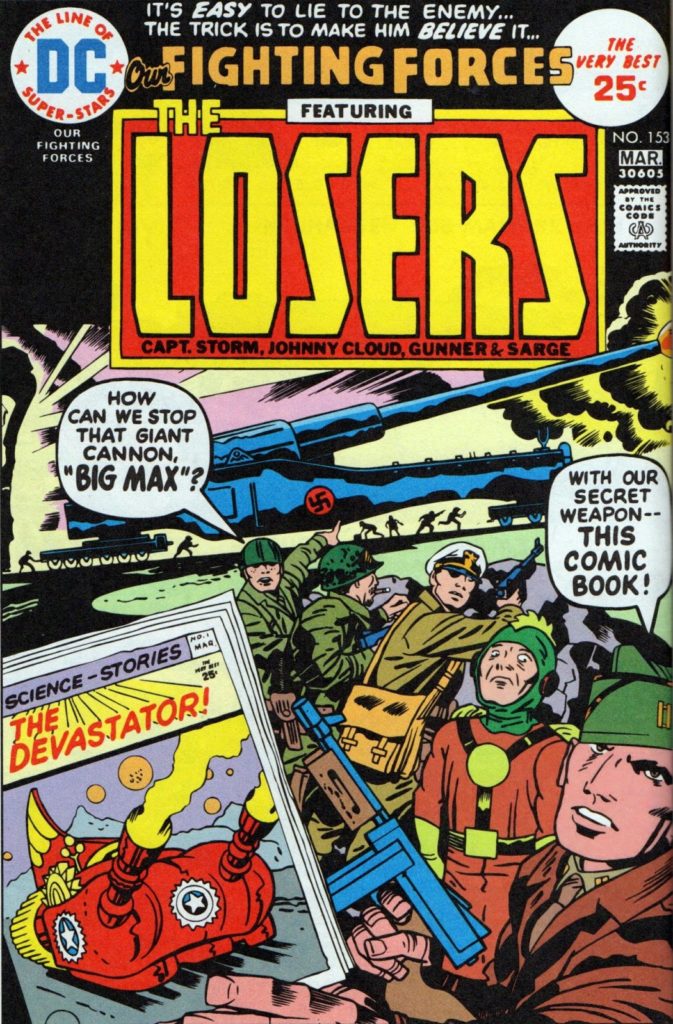
When most people think of Jack Kirby, war comics don’t immediately come to mind. Super-heroes, absolutely. Science fiction, no doubt. Westerns, you bet. Kid gangs, heck yes. Romance — heck, he created the romance comics genre. But war mags? Those were the domain of Kurtzman, Glanzman, Kanigher, Kubert —
And yet, no one knew that war really is hell better than The King. He was on the front lines of the European theater in “The Big One.” He helped liberate more than one concentration camp. He’d seen the horrors of both fascism and the bloody struggle against it firsthand. So if the time ever came when he was assigned a war book, there was no doubt he could do the job.
That time came in the waning months of 1974, when both Kirby and DC’s editorial “brain trust” were well aware that he was essentially riding out his contract there and wouldn’t be “re-upping” once it was done. Kamandi was still selling well, but the entire Fourth World saga had been scuttled, The Demon was likewise suffocated in the crib, and Jack suddenly found himself with a sizable hole in his 15-page-per-week (written, drawn, and edited — damn!) workload obligation. The long-running WWII title Our Fighting Forces — which of late had been featuring the adventures of a hard-luck special forces unit known as The Losers — wasn’t exactly a fan favorite anymore, so the decision was made to shift Jack onto the series in the hope that a little bit of that patented “Kirby Magic” would go some way toward making it stand out from the pack on the newsstands once again. Those who were there at the time, most notably his assistants Mark Evanier and Steve Sherman, have related tales of Kirby being less than thrilled with the gig — a persistent comic-industry “urban legend” has it that he stated he preferred to chronicle the exploits of “winners” — but damn, his reluctance never showed on the page. In point of fact, I have no problem stating that Jack’s brief tenure on OFF (collected in hardcover by DC a few years back as Jack Kirby’s The Losers) contains some of the very best war comics ever made by anyone.
Still, if I had to pick a single stand-out yarn of the bunch — no easy task, I assure you, which is why we might be returning to this title as “Kirby Month” goes along — in a pinch I would probably go with issue number 153, cover-dated February/March 1975 and bearing the compelling, attention-grabbing title of “The Devastator Vs. Big Max.”
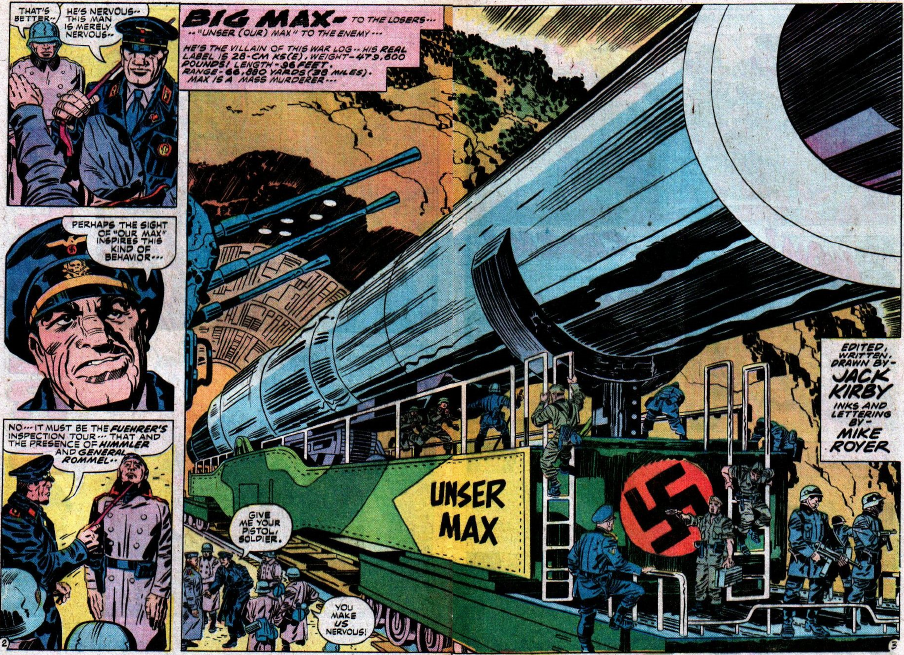
A brief run-down of the series’ premise is probably in order here for those not exactly in the know : the then-titular starring foursome of the book — composed of Captain Storm, Johnny Cloud, Gunner, and Sarge (no fuller name given) — were essentially the ultimate in plausible deniability, given that they were inserted (often by means never even explained) into supposedly “hopeless” situations anywhere the war effort was underway, immediately seconded to whatever branch of the armed forces was in need of their services, and then left on their own to either solve the mess they found themselves in, or die trying — in which case, hey, they were never even officially there, anyway. Issue 153 sees them tasked with taking out a new Nazi “super-cannon” — known as “Unser Max” to “Jerry” or “Big Max” to the Allies — that’s got greater range and firepower than anything ever devised and needs to be obliterated before it can re-shape the course of the entire war. It’s no easy task, to be sure — no job The Losers get stuck with ever is — but fortunately, a shuffle through the sci-fi and adventure pulp magazines and comic books of an imaginative young private named Rodney Rumpkin yields a potential solution: a futuristic tank-like vehicle known as “The Devastator.”
Of course, any potential “Devastator” the Losers can build will be no more “real” than its printed-page counterpart, but by haphazardly slapping together a bunch of junked aircraft parts, they’re able to “MacGyver up” a reasonably convincing facsimile of the battle vehicle from Rodney Rumpkin’s funnybooks, and even throw the red-headed GI himself a bone by putting him in the driver’s seat and outfitting him in a gaudy super-hero costume, to boot! Who says dreams can’t come true?
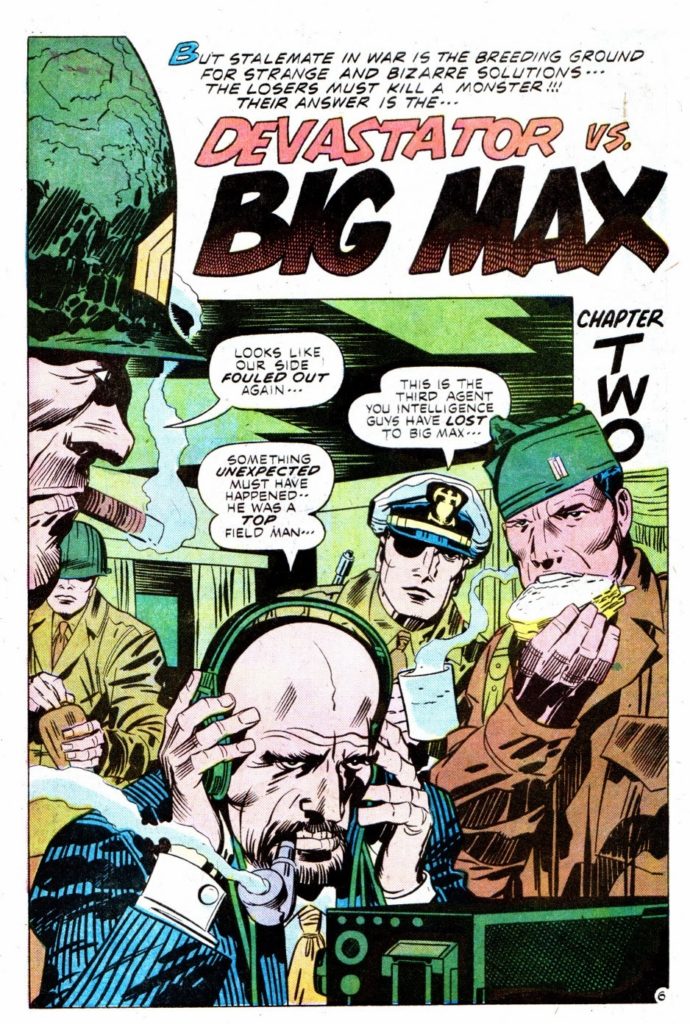
The calculated gamble works — the Germans believe “The Devastator” to be real and haul “Big Max” out into the open in order to meet it head-on, at which point Allied aircraft bomb the shit out of the uber-weapon — but the admittedly clever plot is really secondary to the the story’s thinly-disguised analogy for Kirby’s own situation at the time: yeah, he wasn’t on this book by choice, but dammit, like his stand-in Rodney Rumpkin, he was still fueled by the power of his imagination, and he was still going to do the best he could under less-than-ideal circumstances. You could put Jack Kirby on a less-than-great comic, but you couldn’t stop him from making it great, and this story is certainly “evidence A” of that. Rumpkin may be hopelessly naive, but he represents a sort of eternal optimism that was sorely needed in order to win the war, and he emerges from this adventure mildly disappointed that his “Devastator” was a mere prop, but otherwise unscathed, and just as enthusiastic as ever for his fantastic four-color escapism.
Even in a small-scale story such as this, Kirby’s penchant for the grand spectacle holds sway: “Big Max” isn’t just “big,” it’s huge — the scale of the deception The Losers are employing to get it out onto the field of battle is equally preposterous — but the biggest thing of all is the scale and scope of Rodney Rumpkin’s starry-eyed, childlike imagination. Granted, there’s charm aplenty to be found in this simple tale, and Kirby illustrates the action flawlessly with able assistance from his best and most faithful inker, Mike Royer, but there’s also a timeless message about the power of the human spirit in the face of seemingly-insurmountable odds that’s delivered with such admirable earnestness that one could be forgiven for thinking this comic was the product of a guy who was absolutely thrilled to be making it.
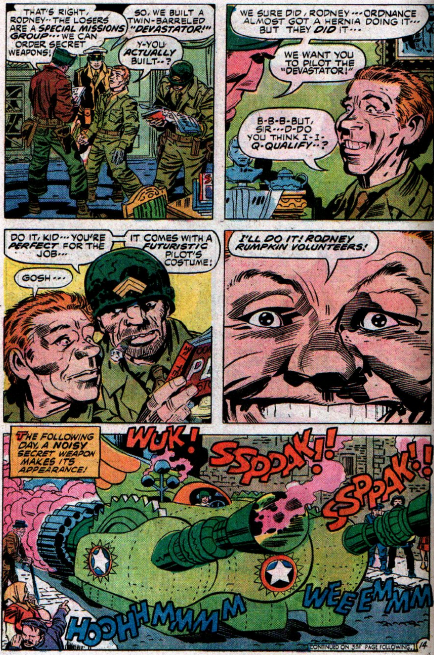
And, ya know, I’m thinking it was. Our Fighting Forces may not have been precisely the comic Kirby wanted to be working on, but it was still a comic — and any comic was a place where he could display his limitless imagination on paper and inspire others to follow their own dreams. So maybe Rodney Rumpkin isn’t mean to symbolize his creator, but us. Or maybe both. I guess the jury’s out on how to interpret some of the rich metaphor on offer in this story, but one thing’s for certain — “The Devastator Vs. Big Max” is an extraordinary piece of work, created under circumstances where most writers and artists would merely be “running out the clock” and “mailing it in.” Kirby had too much respect — both for his own gifts and abilities and for his readers’ hard-earned money — to ever “half-ass it,” though. He accepted an unwanted assignment not as a burden, but as a challenge — and proved that he could produce some of the best work of his singularly stellar career in the pages of a book that he didn’t choose to have fall into his lap, but was nevertheless determined to make the most of once it did.
Hmmm — yeah, maybe he was Rodney Rumpkin after all.
Tags: Comic Books, Comics, DC Comics, Jack Kirby, Kirby Month, Mike Royer

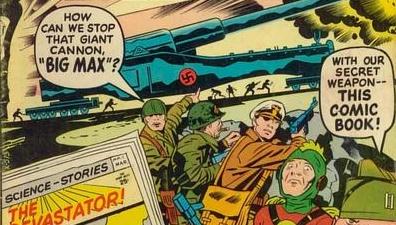
No Comments